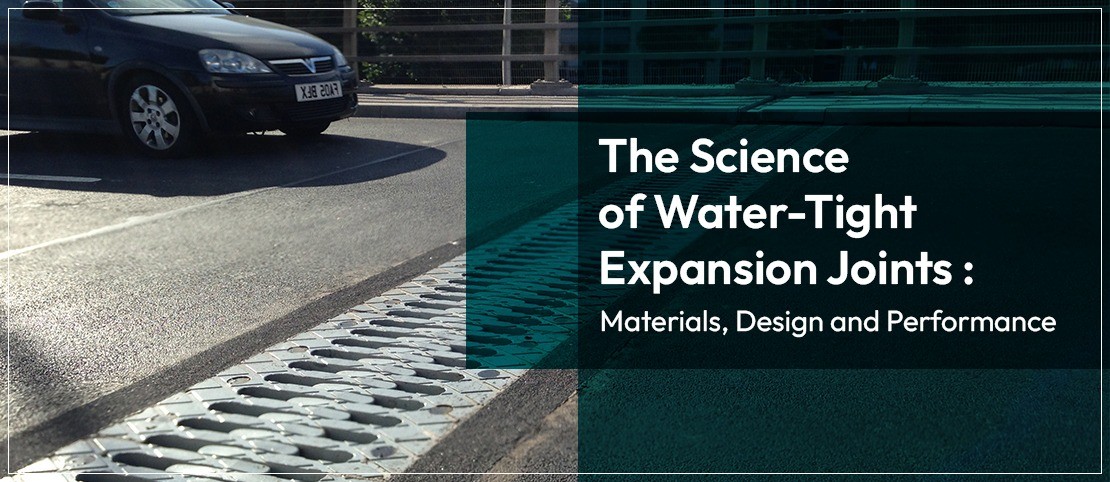The Science of Water-Tight Expansion Joints: Materials, Design, and Performance
In construction and infrastructure projects, water-tight expansion joints are an indispensable element, ensuring the stability of structures against fluctuating temperatures, movement, and environmental conditions. To gain a deep understanding of the science behind these joints, it is crucial to examine the materials, design principles, and performance factors involved.
What Are Expansion Joints?
As we all know buildings are designed to last for a long time. However, changes in temperature, seismic activity, or structural settling can cause damage to these structures. That's why expansion joints are so crucial in construction. These joints allow buildings to flex and move without causing harm. They are strategically placed in different parts of the building, including floors, walls, and facades, so that they can accommodate movement. By doing so, we can ensure that our buildings remain safe and durable for many years to come.
Material Selection
Selecting the right materials for water-tight expansion joints is crucial to ensure their long-term performance and effectiveness in preventing water infiltration. Here are some commonly used materials for water-tight expansion joints:
- Elastomeric Materials:
Neoprene is a synthetic rubber material identified for its flexibility and resistance to water, weathering, and UV exposure. It is generally used in expansion joints due to its ability to retain water-tightness.
EPDM (Ethylene Propylene Diene Monomer) is another type of synthetic rubber that bids brilliant resistance to weathering, ozone, and temperature variations. It is appropriate for outdoor and high-temperature applications.
- Silicone:
Silicone is a versatile material with brilliant resistance to water and extreme temperatures. It is often used in expansion joints where high flexibility and long-term water-tightness are compulsory.
- PVC (Polyvinyl Chloride):
PVC is a durable thermoplastic material used in expansion joints principally in applications where resistance to chemical exposure is very important.
- Thermoplastic Elastomers (TPEs):
TPEs combine the properties of rubber and plastic. They are selected for their flexibility, resistance to environmental conditions, and effortless installation in water-tight expansion joints.
- Metal Alloys:
Stainless steel expansion joints are frequently used in applications where resistance to corrosion and extreme temperatures is required.
- Composite Materials:
Some expansion joints are constructed using composite materials that combine the strengths of various components to achieve water-tightness and flexibility. These materials may include layers of rubber, fabric, and other components.
- Sealant and Adhesive Compounds:
To seal gaps and joints in expansion joint systems sealant technology and adhesive compounds, such as polyurethane sealants or epoxy adhesives are used.
Design Principles
To ensure effectiveness in preventing water infiltration and maintaining structural integrity, the design principles for water-tight expansion joints involves careful consideration. Following are the few key design principles for water-tight expansion joints:
- Flexibility and Movement Accommodation:
Expansion joints essentially accommodate the movement of structures because of the temperature fluctuations, seismic activity, and settling. To prevent cracking and maintain water-tightness during movement, design them to be flexible.
- Sealing Mechanisms:
Integrate effective sealing mechanisms that construct a water-tight barrier while allowing movement. This may include gaskets, compression seals, or bellows that maintain their seal under stress.
- Integrated Water Stops:
Barriers designed to prevent water from traveling through the expansion joint are Water stops. Integrating these into the design enhances water-tightness.
- Joint Configuration:
Based on the movement requirements and environmental conditions, select the appropriate joint configuration, such as open, closed, or semi-open.
Performance Factors
Water-tight expansion joints play a vital role in preventing water infiltration and maintaining the integrity of structures. To ensure their effectiveness, various performance factors must be considered during their design, installation, and maintenance. The key performance factors for water-tight expansion joints are:
- The primary function of water-tight expansion joints is to prevent water infiltration, which can cause significant damage to buildings and infrastructure. Therefore, it is crucial to ensure that these joints remain sealed even when exposed to moisture, rain, or other environmental factors.
- High-quality materials and construction techniques are necessary to guarantee the durability and longevity of expansion joints. By designing these joints to have a long service life, we can minimize maintenance costs and reduce the need for replacements, ultimately saving time and money.
- Compression and flexibility are key properties of expansion joints that allow them to absorb stress and movement while maintaining a water-tight seal. It is crucial to ensure that these joints exhibit these characteristics to guarantee optimal performance.
- Finally, resistance to environmental conditions like UV exposure, temperature extremes, chemical exposure, and corrosion is essential for long-term performance. By designing expansion joints to withstand these factors, we can ensure that they continue to perform well over time, providing peace of mind and enhancing the safety and integrity of buildings and infrastructure.
Conclusion
Water-tight expansion joints are a fascinating combination of material science, engineering principles, and performance requirements. These elements work in unison to produce a crucial component in construction and infrastructure projects, guaranteeing that structures are secure and safeguarded against water infiltration.
It is vital for those engaged in construction and maintenance to comprehend the selection of materials, design principles, and the significance of movement accommodation and durability. As technology and materials improve, expansion joints will continue to be more effective in providing water-tight solutions for various applications.
MBT is one of the leading Expansion Joint trading companies in the UAE. We are known for providing complete solutions for expansion joint systems. MBT offers various expansion joint solutions. We offer solutions for seismic movements, architectural joints, movement joints, bridge expansion joints, fire rated expansion joints, swimming pool joint profiles, and watertight profiles and also customized expansion joint profiles, as to meet the requirements of our clients.
Related Posts
Comments
By accepting you will be accessing a service provided by a third-party external to https://www.mbt-techserv.com/



